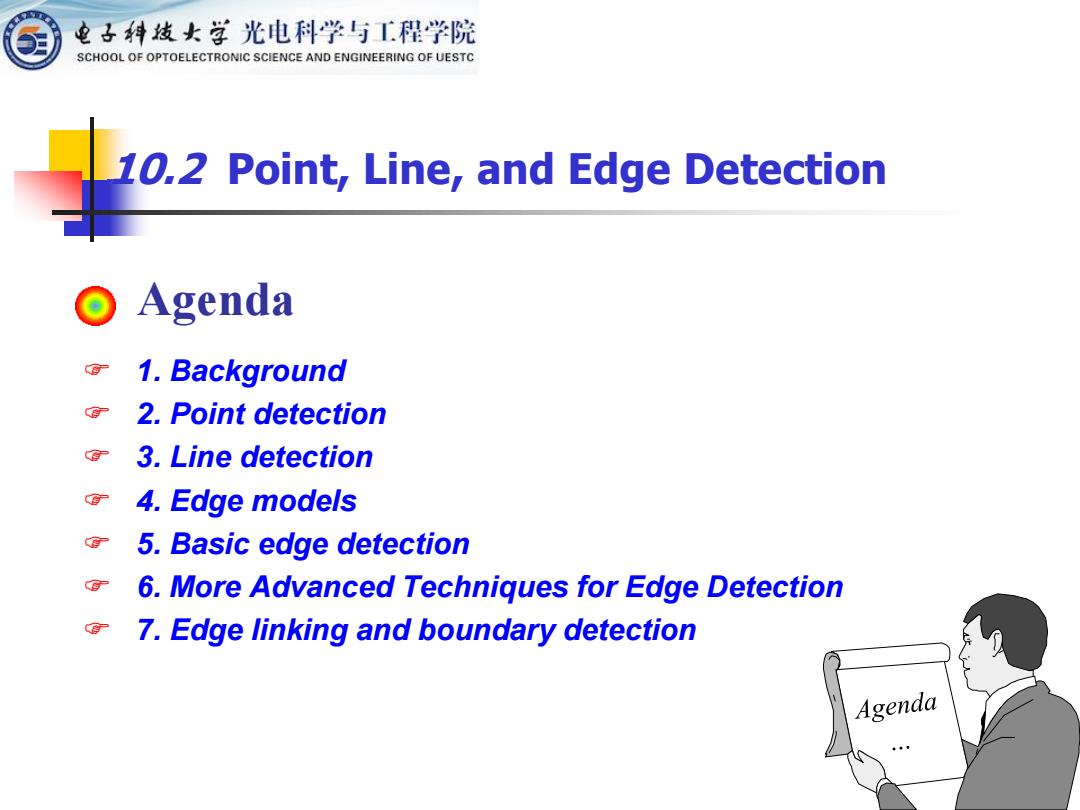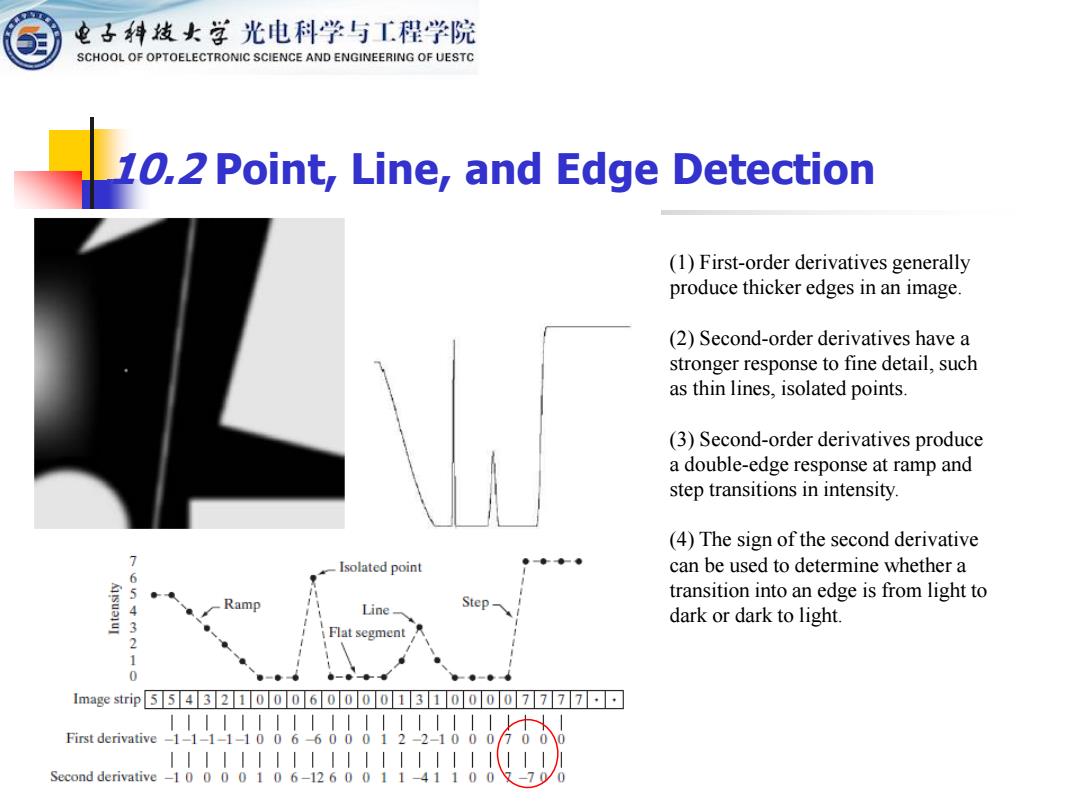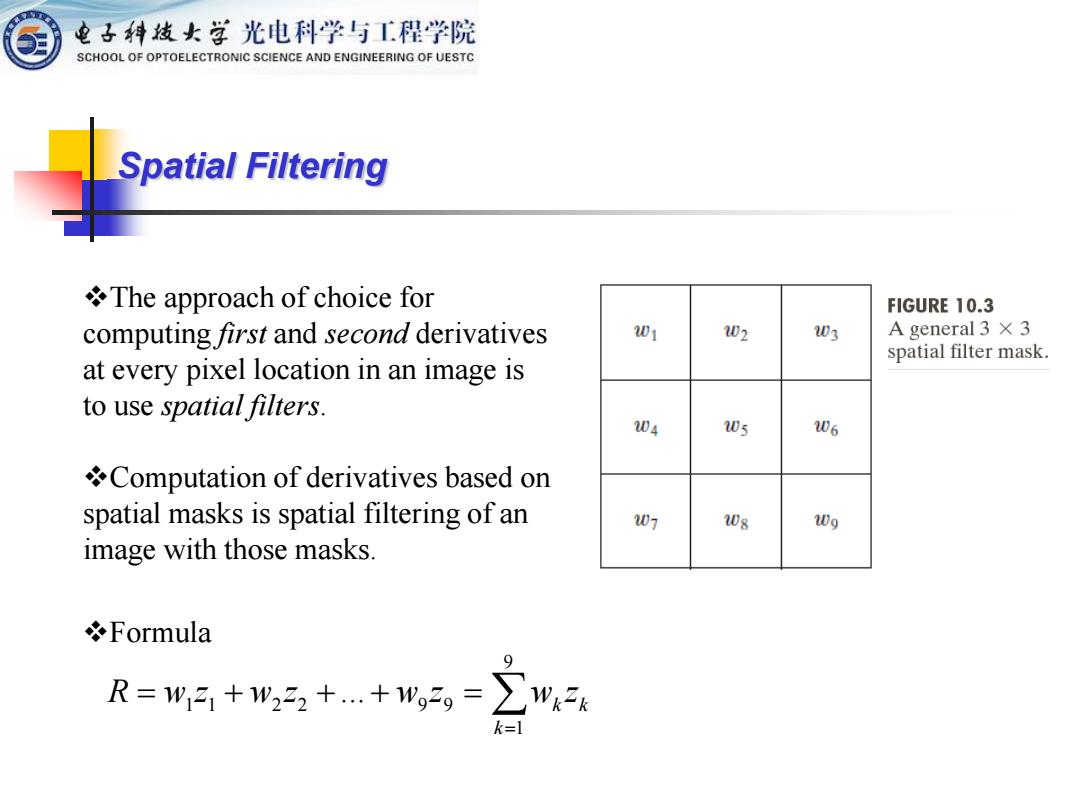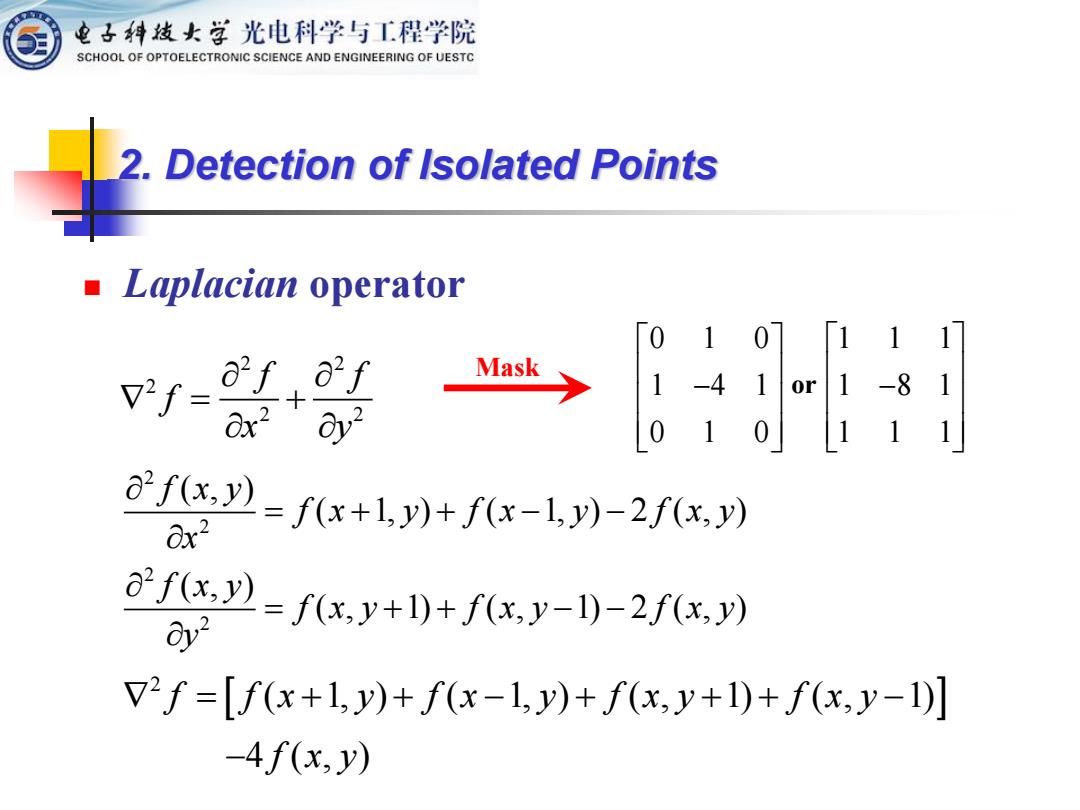
电子科线女学光电科学与工程学院 SCHOOL OF OPTOELECTRONIC SCIENCE AND ENGINEERING OF UESTC 10.2 Point,Line,and Edge Detection Agenda 1.Background g 2.Point detection 3.Line detection g 4.Edge models 5.Basic edge detection 6.More Advanced Techniques for Edge Detection g 7.Edge linking and boundary detection Agenda
1. Background 2. Point detection 3. Line detection 4. Edge models 5. Basic edge detection 6. More Advanced Techniques for Edge Detection 7. Edge linking and boundary detection 10.2 Point, Line, and Edge Detection Agenda

电子科线女学光电科学与工程学院 SCHOOL OF OPTOELECTRONIC SCIENCE AND ENGINEERING OF UESTC 1.Background ■Derivative An approximation to the first-order derivative at point x of a one-dimensional function f(x)by expanding the function f(x+x)into a Taylor series about x letting Ax=1 and keeping only the linear terms (Problem 10.1).The result is the digital difference Y=f'(x)=f(x+1)-f(x) a ==x++1--2 2ff'(☒=f'(x+)-f'() 0x2 Ox =f(x+2)-f(x+1)-f(x+1)+f(x) =f(x+2)-2f(x+1)+f(x)
An approximation to the first-order derivative at point x of a one-dimensional function f (x) by expanding the function f (x+Δx) into a Taylor series about x letting Δx=1 and keeping only the linear terms (Problem 10.1).The result is the digital difference ( ) ( 1) ( ) f f x f x f x x = = + − ◼ Derivative ( ) ( ) ( ) ( ) ( ) ( ) ( ) ( ) ( ) ( ) 2 2 1 2 1 1 2 2 1 f f x f x f x x x f x f x f x f x f x f x f x = = + − = + − + − + + = + − + + ( ) ( ) ( ) ( ) 2 2 1 1 2 f f x f x f x f x x = = + + − − 1. Background

电子科发女学光电科学与工程学院 SCHOOL OF OPTOELECTRONIC SCIENCE AND ENGINEERING OF UESTC 10.2 Point,Line,and Edge Detection (1)First-order derivatives generally produce thicker edges in an image. (2)Second-order derivatives have a stronger response to fine detail,such as thin lines,isolated points. (3)Second-order derivatives produce a double-edge response at ramp and step transitions in intensity. (4)The sign of the second derivative 7 Isolated point can be used to determine whether a 5 transition into an edge is from light to 4 ● Ramp Line- Step 3 dark or dark to light. Flat segment 2 1 0 ● 1 mage strip5543210o06000013100007777- First derivative-1-1-1-1-1006-600012-2-100 Second derivative -10 000 1 0 6-12 6 00 11- 4
10.2 Point, Line, and Edge Detection (1) First-order derivatives generally produce thicker edges in an image. (2) Second-order derivatives have a stronger response to fine detail, such as thin lines, isolated points. (3) Second-order derivatives produce a double-edge response at ramp and step transitions in intensity. (4) The sign of the second derivative can be used to determine whether a transition into an edge is from light to dark or dark to light

电子科线女学光电科学与工程学院 SCHOOL OF OPTOELECTRONIC SCIENCE AND ENGINEERING OF UESTC Spatial Filtering The approach of choice for FIGURE 10.3 computing first and second derivatives 201 102 2D3 A general3×3 spatial filter mask. at every pixel location in an image is to use spatial filters. 04 105 06 Computation of derivatives based on spatial masks is spatial filtering of an 07 208 20g image with those masks. Formula R=w7+w,2++wg2=∑wk2g
Spatial Filtering ❖The approach of choice for computing first and second derivatives at every pixel location in an image is to use spatial filters. ❖Computation of derivatives based on spatial masks is spatial filtering of an image with those masks. 9 1 1 2 2 9 9 1 ... k k k R w z w z w z w z = = + + + = ❖Formula

电子科发女学光电科学与工程学院 SCHOOL OF OPTOELECTRONIC SCIENCE AND ENGINEERING OF UESTC 2.Detection of Isolated Points ■Laplacian operator 0 10 1 11 o'f a'f 2∫=x2 Mask 1 -4 1 or 1-8 1 ay? 0 11 0f(x》=fx+1,)+fx-l,)-2fx,) &x2 0f6x,2=fx,y+1)+fcx,y-)-2/(x,月 Oy V2f=[f(x+1,y)+f(x-1,y)+f(x,y+1)+f(x,y-1)] -4f(x,y)
2 2 2 2 2 f f f x y = + 2. Detection of Isolated Points ◼ Laplacian operator 111 1 8 1 111 − or 0 1 0 1 4 1 0 1 0 − Mask 2 2 2 2 ( , ) ( 1, ) ( 1, ) 2 ( , ) ( , ) ( , 1) ( , 1) 2 ( , ) f x y f x y f x y f x y x f x y f x y f x y f x y y = + + − − = + + − − 2 ( 1, ) ( 1, ) ( , 1) ( , 1) 4 ( , ) f f x y f x y f x y f x y f x y = + + − + + + − −